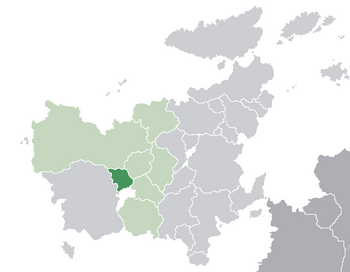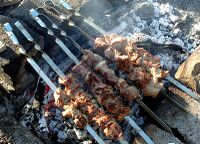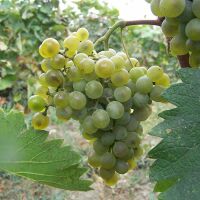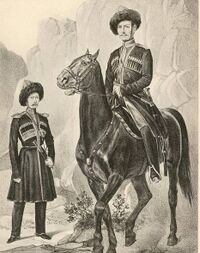Salikhia
This article is incomplete because it is pending further input from participants, or it is a work-in-progress by one author. Please comment on this article's talk page to share your input, comments and questions. Note: To contribute to this article, you may need to seek help from the author(s) of this page. |
Sotirian Republic of Salikhia წაწოლიველო (Salikh) Tsatsolivelo | |
|---|---|
| Motto: „ამ მომენტს საუკუნეებია ველოდებით!” (tr.) "Am moment’s sauk’uneebia velodebit!" "We have been waiting this moment for ages!" | |
| Anthem: „სამშობლოს გამოღვიძება” (tr.) "Samshoblos gamoghvidzeba" "The Awakening of the Homeland" | |
 Salikhia in dark green, within Samorspi, light green. | |
| Capital and largest city | Nerauria (De facto) |
| Official languages | Salikh |
| Ethnic groups (2014) | |
| Demonym(s) | Salikh |
| Government | Unitary teocratic presidential republic |
| Atanas III | |
• Premier | Miku Datunashvili |
| Legislature | Salikh Duma |
| Area | |
• Total | 96,965[1] km2 (37,438 sq mi) |
• Water (%) | 3.5% |
| Population | |
• 2023 estimate | 9,964,740 |
• 2014 census | 9,381,203 [2] |
• Density | 102.76/km2 (266.1/sq mi) |
| GDP (PPP) | 2023 estimate |
• Total | |
• Per capita | |
| GDP (nominal) | 2023 estimate |
• Total | |
• Per capita | |
| Gini (2022) | 37.1 medium |
| HDI (2022) | 0.837 very high |
| Currency | Salikh Lari (₾) (SKL) |
| (DST) | |
| Date format | dd.mm.yyyy |
| Driving side | right |
| ISO 3166 code | BL |
| Internet TLD | .sk |
The Sotirian Republic of Salikhia (Salikh: წაწოლიველო, tr: Tsatsolivelo), also known simply as Salikhia, is a sovereign state in western Euclea. This nation shares borders with Soravia to the north, Laudania and Bistravia to the east, and the Lake Min to the south. Archangel (Salikh: მთავარანგელოზი, tr: Mtavarangelozi) is the capital of the country, and its largest city. Salikhia has a population of 9.9 million and an area of 96,965 km2 (37,438 sq mi) under its administration.
The nation's history dates back to the ancient Tskhannic Empire, the later Kingdom of Salikhia, and latterly Tskhannia and Samkhresalikhia. Salikhia reached its peak during the so-called Classical Era between the 10th and 13th centuries. In the mid-19th century, Salikhia was annexed by the Soravian Empire, which established the State of Salikhia. From 1936 to 1982 Salikhia received the status of Costitutent Oblast, directly administered by Soravia. On 9 March 1982, shortly before the collapse of the Soravian Empire, The Constititent Oblast of Salikhia declared its independence.
Like many post-Soravian countries, Salikhia endured a difficult time during the first half of the 1980s, but through the Christmas Revolution of 1984, Miku Datunashvili assumed the nation's leadership, introducing countless economic, political and diplomatic reforms, which he called part of his Revivalist State, inspired by some of the policies of the defunct ZVNP. Today, Salikhia is one of the fastest growing nations in Euclea, but also one of the most conservative.
Etymology
Salikhia was the name given to the region that currently occupies the homonymous nation, based on a nickname that the inhabitants of the area had for their lands, Tsolikia: This is surely due to the white grape Tsolikouri, endemic to the Salikh northern mounts, and the favorite of foreign explorers and merchants who wandered through the region. The Tsolikouri is the most symbolic of all the vines characteristic of the impressive viticulture of the nation, which is known as the cradle of wine, thanks to its more than 8000 years of tradition. The native name of Salikhia, წაწოლიველო (Tsatsolivelo), then could literally be translated as Land of Wine; the self-denomination for the native language is წაქული (Tsakuli).
History
Salikhia's first stories
The Salikh history begins at the same time as the history of wine; an old legend tells that the Salikh people flourished alongside the vines, being born in the first harvest. Objectively speaking, this legend is probably not far wrong. While we can talk about proto-Salikh populations as far back as the 11th century BC, wine began to form part of the national culture as early as the 9th century BC; the cultivating populations began to form small settlements (mostly in the fertile south), while some other groups remained nomadic (mainly in the more hostile and rugged north). These differences began to divide the proto-Salikh into two groups by the 3rd century BC; the Tsoliki (modern-day Salikh) and the Galoperi (a name derived from the fact that they became famous for being, according to the Tsoliki, "barbarians on horseback"). The Galoperi, having succeeded in domesticating Przewalski's horse around 3500 BC, began to organize into hordes (of up to 80 men), and to expand into western Euclea, mainly to the western coast. Meanwhile, the southern regions beginning to organize into Dzkalabis (city states, probably from the expression dzveli kalakebi, meaning old cities). Slowly, the Galoperi were fighting and learning from other nomadic cultures, such as the Savaders. An empire was beginning to form, the Tskhannic Empire (named after the word tskheni; horse).
Tskhannic Empire & Principality of Archangel
Kingdom of Salikhia
Soravian Conquest
Great Collapse & Great War
Soravian Republic
Provisional Republic
Revivalist State
Current situation
Geography
Administrative divisions
Government and Politics
Government
Administrative divisions
Law and justice
Law enforcement
Foreign relations
Military
- Main article: Salikh Armed Forces
Economy
Agriculture
Transport
Energy and infrastructure
Science and technology
Tourism
Demographics
Major cities
Largest cities or towns in Salikhia
National Institute of Statistics and Census (2014) | |||||||||
|---|---|---|---|---|---|---|---|---|---|
| Rank | Olki | Pop. | |||||||
 Archangel  Aghmosavleti |
1 | Archangel | Samkhresalikhia | 4,117,311 |  Svekvishumi  Kalazumi | ||||
| 2 | Aghmosavleti | Gulia | 567,602 | ||||||
| 3 | Svekvishumi | Samkhresalikhia | 401,283 | ||||||
| 4 | Kalazumi | Sanakhita | 173,301 | ||||||
| 5 | Arauli | Araulebia | 165,995 | ||||||
| 6 | Okroski | Okrosia | 161,732 | ||||||
| 7 | Dziaderumi | Samkhresalikhia | 130,516 | ||||||
| 8 | Maudebi | Vazebia | 106,659 | ||||||
| 9 | Qalqerzi | Tskhannia | 93,409 | ||||||
| 10 | Zorovi | Zorovikhia | 89,577 | ||||||
Ethnicity
Salikhia presents an obvious peculiarity, which lies in the lack of connection with many of its neighboring cultures; outside of what more than two centuries of Soravian occupation brought, the basic aspects of the country's culture are very different from its neighbors, predominantly Marolevs. It is popularly accepted that, at some point in history, small Piraean populations moved into the territory that is now Salikhia in order to find new arable and pleasant land; Salikhia not only had that, but it also had the first wine productions ever recorded. The travelers, delighted, named these lands as βιολέτια (tr. Violétia; referring to the purple color of the grapes), and moved the novelty towards their homelands, -novelty- that quickly spread throughout Solaria. Some travelers decided to settle in Salikhia, mixing with the natives, and forming the first evidence of a proto-Salikh Tsoliki population, which would spread along the northern shore of Lake Min, and even into the mountainous regions a few hundred kilometers to the north; these groups that decided to leave the coast to move north, slowly became isolated from the southern populations, forming their own subdivision, the Galoperi.
In the local language, the area was known as Tsolikia, which led to the fact that a few centuries later, that name was written for the first time as Salikhia, reaching a consensus between local and foreign merchants, who could not decide on one name or another; all the territories that had a population mainly made up of Tsoliki, Galoperi, or both, was considered generically as part of Salikhia.
Even with the difficulties of the land, for the moment before the Soravian conquest, the Galoperi were by number of inhabitants, almost as numerous as the Tsoliki; after the conquest, the Galoperi not only meant a minuscule number within the population of the territory, but their culture was persecuted, and assimilated within the Soravian aspects; the fate of the Galoperi, considered as a barbaric population was to accept the established conditions, or to go into exile to the most unreachable areas of the country, such as the Sakhchak Mountains, or similar; in later years and eras, the non-exiled Galoperi could be seen fighting alongside Soravia, or other nations, as mercenaries; this was also the fate of other Tsoliki fortune hunters.
Contemporaneously, President Miku Datunashvili, ethnically Galoperi, has consolidated the north of the nation as the productive heart of the country, with great exponents such as Okroski, the city of gold; or Dziaderumi, the city of steel. Immigration is not a common occurrence in the nation, and tends to take place almost exclusively for labor reasons, mainly from Laudania and neighboring Soravian oblasts.
Salikh identity
Language
Religion
Health
Education
Culture
Heritage Sites
Architecture
Visual Art
Performing arts
Philosophy
Sport
Sport in Salikhia is characterized by an extraordinary relevance of Football, other sports have a more reserved popularity in comparison. The first national sports idol was Nikola Berikashvili (also known by his Soravian surname, Berikov), nicknamed The Illusionist of Kalazumi, who excelled as an offensive midfielder, a key box to box in the Soravian team that reached the Final of the Coupe du Monde in 1963, which the Serzhanty would end up losing against the then reigning champions, Etruria; on that edition, Berikashvili scored 5 goals, and contributed with 7 assists, being voted the best player of the tournament.
Nikola Berikashvili was also the Coach of the miraculous Salikhia who, in their debut tournament in 1995, reached the final of the tournament, in which were defeated against Werania. The Salikh generation, from that 1995 edition until 2003, became known as the Bolnisi Boys, reaching a third place in 1999, and, again, another final in 2003, now losing against Valduvia. Salikhia would never again reach a Coupe du Monde semifinal -or even a knockout stage-. The thee most popular clubs at the national level are Zorovi Wanderers, from the homonymous city; and Kapitalielebi & Alumni Athletic, from Mtavarangelozi, commonly referred to as the Wealthy (Alumni), the Broke (Kapitalielebi) and the Lady (Wanderers).
Motorsport is also quite maintream, especially since the rapid industrialization of the country, which fostered motorization and Car Spotting as a new fashion and trend, born in the late 80's. Auto Racing and Drifting competitions, legal and illegal, reached their peak in the 90's and the new millennium, with both domestic and imported models. Salikhia maintains an extensive car culture to this day, with new circuits and venues opening every year. Speaking now of Formula Kylaris, Salikhia has one circuit on the calendar, the historic last date, the Zorovring, built in 1941, still under Soravian occupation; the Zorovring was renovated multiple times over the eras, and its layout was progressively shortened to adapt to new regulations. The original layout is practically abandoned, and today, only the East Sector of the circuit is operational.
Rugby enjoys a certain popularity, considerably less than that of the first two. Its biggest followers come mainly from the capital, being that most of the country's most prominent institutions, at least in this sport, are based in Archangel, such as Alumni or Dideba.
The national sport is Tarpalma, a martial art based on classic fencing and legendary gladiator fights. The current professional Tarpalma is practiced with full armor, and swords of any kind, even a shield if the sword is wielded by one hand only; the most popular variant of the game lasts until one of the fighters receives three 'cuts' in any part of the body, or one, in the neck or head. The teaching of Tarpalma is compulsory for male students - for female students, optional - in all schools in the country, practiced first with wooden swords at the primary level, and then moving on to real swords once the secondary level is reached. There's official regulated tournaments as well as unregulated street tournaments, which are quite common, and a tourist attraction. The sport is considered an intangible heritage of the nation, and several attempts were made to export the discipline, mainly to countries neighboring Salikhia, with moderate success.
Cuisine
Salikh cuisine can vary greatly depending on the region we are talking about; typically and making some generalisations, the northern regions, heirs to the cuisine of old Tskhannia, tend to prefer more rustic and simple dishes, based on grilled meats; the southern regions, historically more developed, tend to prefer more delicate and complex preparations, such as Khinkali, or Khachapuri. The most common ingredients tend to revolve around wine, dairy products, walnuts, peanuts, and olives.

During winter and Easter, the consumption of Sturgeon is almost commonsense, the most common way to do it marinating pecially cut pieces with a sauce based on tomato paste and yogurt, seasoned with ginger and other spices, and then skew the fish on a 'sword', making what is locally called shemtsvarikhmali, cooking the result over a fire or grill. The shemtsvarikhmali, not only of Sturgeon, but also using any type of meat, is the national dish of the country, being consumed in social and family gatherings, thanks to its easy and fast prepation. This dish has its origins in the Tskhannic Empire, being a popular meal among the soldiers of the hordes, as it only required a clean sword, fire, and any meat or fish that was available at the moment.
Salikh cuisine and wine have evolved through the centuries, adapting traditions in each era. One of the most unusual traditions on the table is supra, or Salikh table, which is also a way of socializing with friends and family. The head of supra is known as tamada; he also conducts the highly philosophical toasts, and makes sure that everyone is enjoying themselves. A successful tamada must be able to hold long and interesting talks, and be able to drink heavily without showing almost any signs of drunkenness. Rather than serving food in courses, traditional supras often present all that a host has to offer.
Salikhia's moderate climate and moist air, influenced by the Lake Min, provide the best conditions for vine cultivation. The soil in vineyards is so intensively cultivated that the grapevines grow up the trunks of fruit trees eventually hanging down along the fruit when they ripen. This method of cultivation is called maglari. Wine, and its associated traditions, is an indispensable part of the national identity and is probably the most recognized aspect of the country worldwide.


















